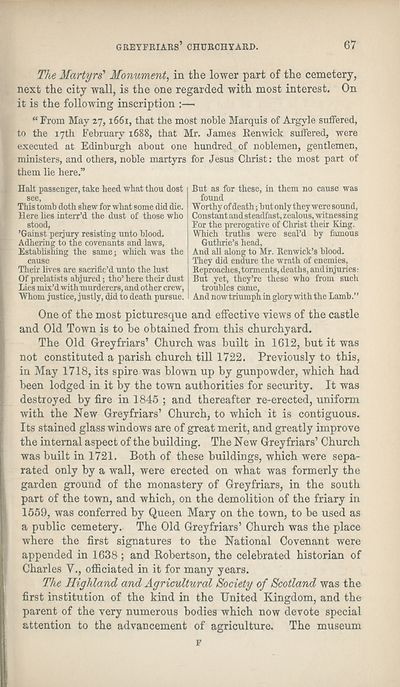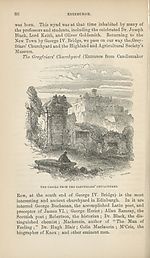Download files
Complete book:
Individual page:
Thumbnail gallery: Grid view | List view

GREYFRIARS’ CHURCHY ARB.
67
The Martyrs' Monument, in the lower part of the cemetery,
next the city wall, is the one regarded with most interest. On
it is the following inscription :—
“ From May 27,1661, that the most noble Marquis of Argyle suffered,
to the 17th February 1688, that Mr. James Renwick suffered, were
executed at Edinburgh about one hundred of noblemen, gentlemen,
ministers, and others, noble martyrs for Jesus Christ: the most part of
them lie here.”
Halt passenger, take heed what thou dost
This tomb doth shew for what some did die.
Here lies interr’d the dust of those who
’Gainst’perjury resisting unto blood.
Adhering to the covenants and laws,
Establishing the same; which was the
Their lives are sacrific’d unto the lust
Of prelatists abjured; tho’ here their dust
Lies mix’d with murderers, and other crew,
Whom justice, justly, did to death pursue.
But as for these, in them no cause was
Worthy of death; but only they were sound.
Constant and steadfast, zealous, witnessing
For the prerogative of Christ their King.
Which truths were seal’d by famous
Guthrie’s head.
And all along to Mr. Renwick’s blood.
They did endure the wrath of enemies.
Reproaches, torments, deaths, andinjuries:
But yet, they’re these who from such
troubles came.
And now triumph in glory with the Lamb.”
One of the most picturesque and effective views of the castle
and Old Town is to be obtained from this churchyard.
The Old Oreyfriars’ Church was built in 1612, but it was
not constituted a parish church till 1722. Previously to this,
in May 1718, its spire was blown up by gunpowder, which had
been lodged in it by the town authorities for security. It was
destroyed by fire in 1845 ; and thereafter re-erected, uniform
with the New Greyfriars’ Church, to which it is contiguous.
Its stained glass windows are of great merit, and greatly improve
the internal aspect of the building. The New Greyfriars’ Church
was built in 1721. Both of these buildings, which were sepa¬
rated only by a wall, were erected on what was formerly the
garden ground of the monastery of Greyfriars, in the south
part of the town, and which, on the demolition of the friary in
1559, was conferred by Queen Mary on the town, to be used as
a public cemetery. The Old Greyfriars’ Church was the place
where the first signatures to the National Covenant were
appended in 1638 ; and Robertson, the celebrated historian of
Charles V., officiated in it for many years.
The Highland and Agricultural Society of Scotland was the
first institution of the kind in the United Kingdom, and the
parent of the very numerous bodies which now devote special
attention to the advancement of agriculture. The museum
67
The Martyrs' Monument, in the lower part of the cemetery,
next the city wall, is the one regarded with most interest. On
it is the following inscription :—
“ From May 27,1661, that the most noble Marquis of Argyle suffered,
to the 17th February 1688, that Mr. James Renwick suffered, were
executed at Edinburgh about one hundred of noblemen, gentlemen,
ministers, and others, noble martyrs for Jesus Christ: the most part of
them lie here.”
Halt passenger, take heed what thou dost
This tomb doth shew for what some did die.
Here lies interr’d the dust of those who
’Gainst’perjury resisting unto blood.
Adhering to the covenants and laws,
Establishing the same; which was the
Their lives are sacrific’d unto the lust
Of prelatists abjured; tho’ here their dust
Lies mix’d with murderers, and other crew,
Whom justice, justly, did to death pursue.
But as for these, in them no cause was
Worthy of death; but only they were sound.
Constant and steadfast, zealous, witnessing
For the prerogative of Christ their King.
Which truths were seal’d by famous
Guthrie’s head.
And all along to Mr. Renwick’s blood.
They did endure the wrath of enemies.
Reproaches, torments, deaths, andinjuries:
But yet, they’re these who from such
troubles came.
And now triumph in glory with the Lamb.”
One of the most picturesque and effective views of the castle
and Old Town is to be obtained from this churchyard.
The Old Oreyfriars’ Church was built in 1612, but it was
not constituted a parish church till 1722. Previously to this,
in May 1718, its spire was blown up by gunpowder, which had
been lodged in it by the town authorities for security. It was
destroyed by fire in 1845 ; and thereafter re-erected, uniform
with the New Greyfriars’ Church, to which it is contiguous.
Its stained glass windows are of great merit, and greatly improve
the internal aspect of the building. The New Greyfriars’ Church
was built in 1721. Both of these buildings, which were sepa¬
rated only by a wall, were erected on what was formerly the
garden ground of the monastery of Greyfriars, in the south
part of the town, and which, on the demolition of the friary in
1559, was conferred by Queen Mary on the town, to be used as
a public cemetery. The Old Greyfriars’ Church was the place
where the first signatures to the National Covenant were
appended in 1638 ; and Robertson, the celebrated historian of
Charles V., officiated in it for many years.
The Highland and Agricultural Society of Scotland was the
first institution of the kind in the United Kingdom, and the
parent of the very numerous bodies which now devote special
attention to the advancement of agriculture. The museum
Set display mode to:
![]() Universal Viewer |
Universal Viewer | ![]() Mirador |
Large image | Transcription
Mirador |
Large image | Transcription
| Antiquarian books of Scotland > Scotland/Scots > Black's picturesque tourist of Scotland > (119) |
|---|
| Permanent URL | https://digital.nls.uk/130029618 |
|---|
| Description | Thousands of printed books from the Antiquarian Books of Scotland collection which dates from 1641 to the 1980s. The collection consists of 14,800 books which were published in Scotland or have a Scottish connection, e.g. through the author, printer or owner. Subjects covered include sport, education, diseases, adventure, occupations, Jacobites, politics and religion. Among the 29 languages represented are English, Gaelic, Italian, French, Russian and Swedish. |
|---|

